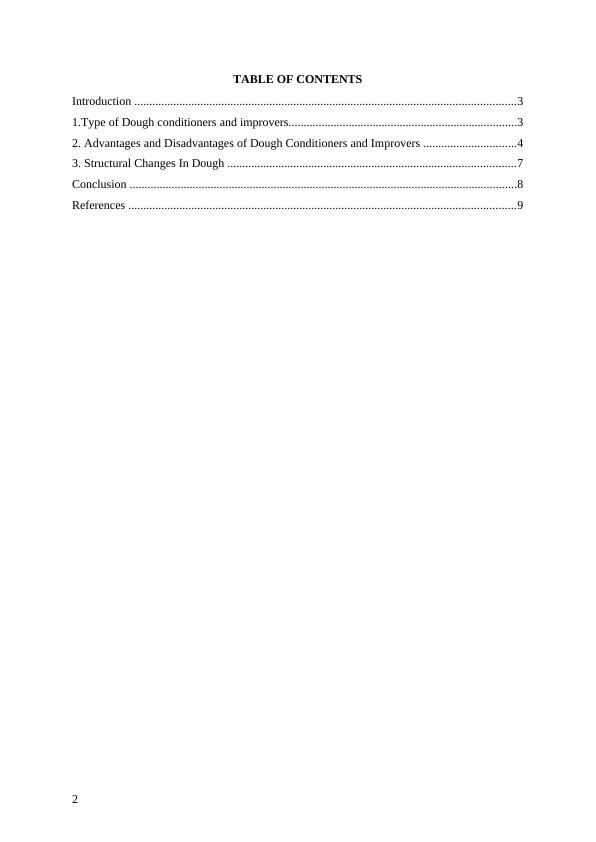Ask a question from expert
Advantages and Disadvantages of Dough
10 Pages2708 Words658 Views
Added on 2020-01-28
Advantages and Disadvantages of Dough
Added on 2020-01-28
BookmarkShareRelated Documents
DOUGH CONDITIONERS ANDIMPROVERS1

TABLE OF CONTENTSIntroduction ...............................................................................................................................31.Type of Dough conditioners and improvers............................................................................32. Advantages and Disadvantages of Dough Conditioners and Improvers ...............................43. Structural Changes In Dough ................................................................................................7Conclusion .................................................................................................................................8References .................................................................................................................................92

INTRODUCTIONDough conditioners and improvers are majorly used in bread industry so as toimprove the quality and texture zaof bread. There are varied range of dough conditioners thatare used in baking breads. The report proposed herewith emphasizes on evaluating differentvarieties of dough conditioners and improvers that are utilized by bread industry in today’sworld. The investigation is conducted for following three types of bread conditioners: Yeastnutrients (ammonium sulphate), Emulsifiers (mono-glycerides and SodiumStearoylLactylate) and Lecitin (a natural substance). The report emphasizes on identifyingdifferent kinds of dough conditioners with their advantages & disadvantages and structuralchanges in dough due to usage of dough conditioners. 1.TYPEOF DOUGHCONDITIONERSANDIMPROVERSDough conditioners can be described as elements or a combination of such elementswhich are included to leaven wheat and rye the dough being prepared. Thus, adding theseingredients in the dough shall not only improve the dough process but shall also enhance thespecific characteristics which result into a good dough (Ali and Halim, 2013). Apart fromthese improvements, it also enhances the gas formation, volume of the loaf, structure ofcrumb and the texture which shall be resulted and such other characteristics which improvesthe overall dough strength and quality. In essence these are the bread improvers whichinclude a coherent as well as balanced combination of ingredients which are used or mixedtogether in a suitable quantity to produce bread of good quality (Dough Conditioners, 2017).There are various chemicals and natural substances available in the market for improving thecondition of dough and the resultant bread loaf. Moreover, these ingredients are either used asa whole or in a combination of another ingredient. Some of such commercial substances are:Oxidising Agents - These agents operate oxidize the element of free sulfhydryl whichare essentially groups of gluten to formulate a disulfide bonds. This in turn createsprotein structure which is cross-linked in nature and due to which a strong glutennetwork is evolved with a higher gas retention capacity. Some of the specificexamples of this agent are ascorbic acid, potassium iodate and azodicarbonamide(Grill, 2009). Yeast Nutrients - These are the ingredients which support yeast growth, specificallyin the case of sponge as well as dough, in addition to the long fermentation processes.Ammonium Sulphate is one of the examples which is used as a yeast nutrient and alsohas the effect of producing carbon dioxide in an increased format (Tenbergen, 2016). 3

End of preview
Want to access all the pages? Upload your documents or become a member.
Related Documents
Dough Conditioners and Improverslg...
|9
|2270
|217
Food Science Technologies of Fermentation for Artisan Bread Productslg...
|2
|498
|325